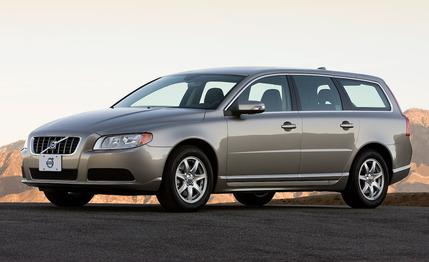
 Road Test
Road Test
In our last road test of a Volvo sedan [May 2007], we likened a top-of-the-line S80 AWD’s appeal to eating particle board. Given that the V70 wagon is based on the S80, the outlook for Volvo’s new wagon is not good.
But hold on a minute. One reason for our lack of enthusiasm for the loaded S80 AWD V-8 was its $56,025 as-tested price tag, putting it in a segment with exemplary models from BMW, Audi, and Mercedes. The V70, available only in front drive with a 3.2-liter inline six-cylinder engine, rings up at a base price of $33,210. At that number, the V70 is an entirely different proposition. It’s even $6240 cheaper than the six-cylinder S80 and $4310 less that its all-wheel-drive sibling, the XC70. And despite the price break, the V70 rides on the same platform as the S80. That means the same crash structure and the same safety equipment: front, side, and curtain airbags; anti-whiplash headrests; and panic brake assist.
Things are looking better for the V70 than its sedan sibling. On a literal level, the V70’s looks are underwhelmingly pleasant. The old V70 went out of its way to define a new look for Volvo. The new wagon is a step backward from that boldness. Its character has been ironed out in the form of smoother, rounded sheetmetal. The new design retains the rear taillights that run from the bumper to the roof, now a Volvo wagon trademark. The V70 looks thoroughly modern, even classy, but it’s not going to shatter any preconceptions about the stylishness of wagons.
The previous V70 was based on the smaller S60 sedan, so it’s not surprising that the new car is longer (up 4.5 inches to 189.9), wider (73.3 inches, an increase of 2.3), and taller (by two inches, to 60.6) than before. The wheelbase has stretched 2.3 inches to 110.8. Compared with the V70 T5 we tested in July 2000, the ’08 V70 is 156 pounds heavier.
The V70’s only available engine is the 3.2-liter inline six-cylinder making 235 horsepower and 236 pound-feet of torque. It’s a big gain from the 157 horsepower that the old base engine produced and only 12 horsepower shy of the go-fast T5’s 247.
The inline-six has its appeal, even if it lacks the oomph of the old T5. It’s the same engine found in other Volvos, as well as in the Land Rover LR2, and it features variable intake-valve timing. It’s mated to a six-speed automatic. Smooth is the name of the game, and unlike in the old turbo, torque steer is nearly imperceptible.
The 0-to-60-mph sprint happens in a respectable 7.5 seconds. That’s only 0.3 second behind the T5 and more than a second quicker than the V70 Cross Country with the base engine that we tested in October 2000.
Respectable, yes, but perhaps not noteworthy. This seems to be a recurring theme. The V70, however, only comes across as a wallflower because it takes a while for its charm to sneak up on you. Generally, we’re not fans of a spongy brake pedal and muffled steering feel, but both reflect the V70’s serene nature. Of course, we would applaud a stopping distance shorter than 178 feet, grip greater than 0.83 g, or handling that would make us wish even more for a stability-control system that turned off completely. Sure, it doesn’t corner like a BMW, but it doesn’t seem like that’s what the V70 is going for, unlike the S80. If you’re looking for more sport in your wagon, you might find it in the Saab 9-5 SportCombi, Subaru Outback 2.5XT, or Volkswagen Passat 3.6 4MOTION. But only the Subaru is close on price—the VW and the Saab are nearly 40 grand—and none of those cars feels as solid and composed as the V70 going down the road. The quiet comfort that the V70 provides is the automotive equivalent of Grandma’s meatloaf. It makes you feel better after a long day.